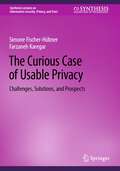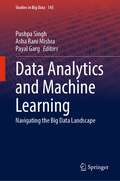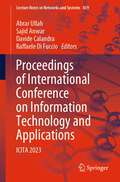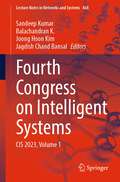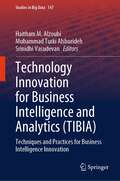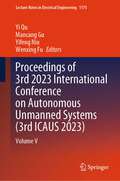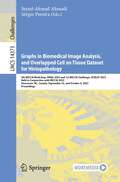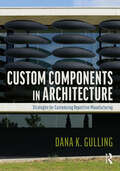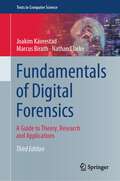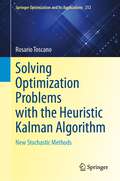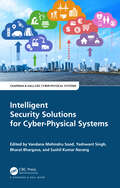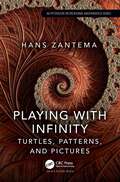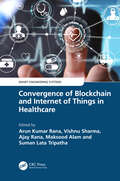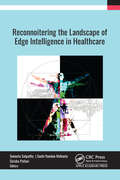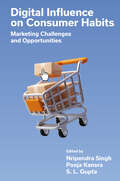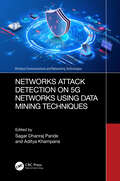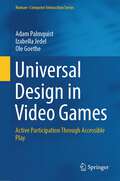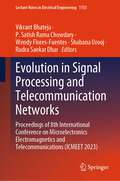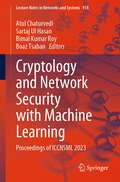- Table View
- List View
The Curious Case of Usable Privacy: Challenges, Solutions, and Prospects (Synthesis Lectures on Information Security, Privacy, and Trust)
by Simone Fischer-Hübner Farzaneh KaregarThis book journeys through the labyrinth of usable privacy, a place where the interplay of privacy and Human-Computer Interaction (HCI) reveals a myriad of challenges, solutions, and new possibilities. Establishing a solid understanding of usable privacy research, practices, and challenges, the book illuminates for readers the often shadowy corridors of such a multifaceted domain and offers guidelines and solutions to successfully traverse the challenging maze. The book does not simply focus on data protection or legislative frameworks but also on what it takes for privacy to be safeguarded, understood, embraced, and easily practiced by all. It begins with a thorough exploration of the background of privacy tools and technologies, the evolution of privacy rules and regulations, and the backdrop upon which this narrative unfolds. After establishing this context, its next important focus is the current state and future directions of the field, including thefrontiers of usable privacy research in relation to the Internet of Things (IoT), usability of PETs, and usable privacy for UX and software developers. The book also considers the often-overlooked privacy narratives of marginalized communities and delves into the complexities of user-centric privacy. Readers are provided with a blueprint for addressing these hurdles and establishing pathways for a more privacy-conscious world. The text will be of interest to students studying Computer Science, Information Systems, or Law, as well as researchers and practitioners working in the fields of usable privacy, privacy by design, Privacy-Enhancing Technologies (PETs), or HCI. All will benefit from the book’s central deliberation of a question that echoes through time and technological advancements: why does usable privacy matter?
Data Analytics and Machine Learning: Navigating the Big Data Landscape (Studies in Big Data #145)
by Pushpa Singh Asha Rani Mishra Payal GargThis book presents an in-depth analysis of successful data-driven initiatives, highlighting how organizations have leveraged data to drive decision-making processes, optimize operations, and achieve remarkable outcomes. Through case studies, readers gain valuable insights and learn practical strategies for implementing data analytics, big data, and machine learning solutions in their own organizations. The book discusses the transformative power of data analytics and big data in various industries and sectors and how machine learning applications have revolutionized exploration by enabling advanced data analysis techniques for mapping, geospatial analysis, and environmental monitoring, enhancing our understanding of the world and its dynamic processes. This book explores how big data explosion, the power of analytics and machine learning revolution can bring new prospects and opportunities in the dynamic and data-rich landscape. It highlights the future research directions in data analytics, big data, and machine learning that explores the emerging trends, challenges, and opportunities in these fields by covering interdisciplinary approaches such as handling and analyzing real-time and streaming data.
Proceedings of International Conference on Information Technology and Applications: ICITA 2023 (Lecture Notes in Networks and Systems #839)
by Abrar Ullah Sajid Anwar Davide Calandra Raffaele Di FuccioThis book includes high-quality papers presented at 17th International Conference on Information Technology and Applications (ICITA 2023), held in Turin, Italy during 20 – –22 October 2023. The book presents original research work of academics and industry professionals to exchange their knowledge of the state-of-the-art research and development in information technology and applications. The topics covered in the book are cloud computing, business process engineering, machine learning, evolutionary computing, big data analytics, internet of things and cyber-physical systems, information and knowledge management, computer vision and image processing, computer graphics and games programming, mobile computing, ontology engineering, software and systems modelling, human computer interaction, online learning /e-learning, computer networks, and web engineering.
Fourth Congress on Intelligent Systems: CIS 2023, Volume 1 (Lecture Notes in Networks and Systems #868)
by Sandeep Kumar Balachandran K. Joong Hoon Kim Jagdish Chand BansalThis book is a collection of selected papers presented at the Fourth Congress on Intelligent Systems (CIS 2023), organized by CHRIST (Deemed to be University), Bangalore, India, under the technical sponsorship of the Soft Computing Research Society, India, during September 4–5, 2023. It includes novel and innovative work from experts, practitioners, scientists, and decision-makers from academia and industry. It covers topics such as the Internet of Things, information security, embedded systems, real-time systems, cloud computing, big data analysis, quantum computing, automation systems, bio-inspired intelligence, cognitive systems, cyber-physical systems, data analytics, data/web mining, data science, intelligence for security, intelligent decision-making systems, intelligent information processing, intelligent transportation, artificial intelligence for machine vision, imaging sensors technology, image segmentation, convolutional neural network, image/video classification, soft computing for machine vision, pattern recognition, human-computer interaction, robotic devices and systems, autonomous vehicles, intelligent control systems, human motor control, game playing, evolutionary algorithms, swarm optimization, neural network, deep learning, supervised learning, unsupervised learning, fuzzy logic, rough sets, computational optimization, and neuro-fuzzy systems.
Technology Innovation for Business Intelligence and Analytics: Techniques and Practices for Business Intelligence Innovation (Studies in Big Data #147)
by Haitham M. Alzoubi Muhammad Turki Alshurideh Srinidhi VasudevanThis book provides a standpoint on how to effectively use technology innovation for business intelligence and analytics. It presents an approach that combines cutting-edge technological advancements with practical applications in the business world. The book covers a range of innovative technologies and how they can be applied to enhance business intelligence and analytics. It is primarily aimed at professionals in the business field data analysts and students studying subjects. This book is especially beneficial for those who want to grasp and apply the technological trends in making strategic business decisions. Its comprehensive coverage makes it an indispensable resource for anyone, in the intersection of technology and business analytics.
Proceedings of 3rd 2023 International Conference on Autonomous Unmanned Systems: Volume V (Lecture Notes in Electrical Engineering #1175)
by Yi Qu Mancang Gu Yifeng Niu Wenxing FuThis book includes original, peer-reviewed research papers from the 3rd ICAUS 2023, which provides a unique and engaging platform for scientists, engineers and practitioners from all over the world to present and share their most recent research results and innovative ideas. The 3rd ICAUS 2023 aims to stimulate researchers working in areas relevant to intelligent unmanned systems. Topics covered include but are not limited to: Unmanned Aerial/Ground/Surface/Underwater Systems, Robotic, Autonomous Control/Navigation and Positioning/ Architecture, Energy and Task Planning and Effectiveness Evaluation Technologies, Artificial Intelligence Algorithm/Bionic Technology and their Application in Unmanned Systems.The papers presented here share the latest findings in unmanned systems, robotics, automation, intelligent systems, control systems, integrated networks, modelling and simulation. This makes the book a valuable resource for researchers, engineers and students alike.
Graphs in Biomedical Image Analysis, and Overlapped Cell on Tissue Dataset for Histopathology: 5th MICCAI Workshop, GRAIL 2023 and 1st MICCAI Challenge, OCELOT 2023, Held in Conjunction with MICCAI 2023, Vancouver, BC, Canada, September 23, and October 4, 2023, Proceedings (Lecture Notes in Computer Science #14373)
by Seyed-Ahmad Ahmadi Sérgio PereiraThis LNCS conference volume constitutes the proceedings of the MICCAI Workshop GRAIL 2023 and MICCAI Challenge OCELOT 2023, Held in Conjunction with MICCAI 2023, Vancouver, BC, Canada, September 23, and October 4, 2023. The 9 full papers (GRAIL 2023) and 6 full papers (OCELOT 2023) included in this volume were carefully reviewed and selected from GRAIL 14 (GRAIL 2023) and 6 (OCELOT 2023) submissions. The conference GRAIL 2023 a wide set of methods and application and OCELOT 2023 focuses on the cover a wide range of methods utilizing tissue information for better cell detection, in the sense of training strategy, model architecture, and especially how to model cell-tissue relationships.
Custom Components in Architecture: Strategies for Customizing Repetitive Manufacturing
by Dana GullingThis book offers architects strategies in the design and manufacturing of custom, repetitively manufactured building components.A total of 36 case studies from around the globe demonstrate the diversity of CRM in architecture and are contributed by architecture firms, including Diller Scofidio + Renfro, Kengo Kuma & Associates, Abin Design Studio, Behnisch Architekten, Belzberg Architects, and many more. The book is organized by manufacturing process and covers the use of various types of glass, clay, plastic, metal, wood, plaster, and concrete. Each process is described with diagrams and text and expanded with one or more examples of customized building components. Projects included are of buildings of various types, sizes, and clients, and many deviate from the typical manufacturing process as they include a secondary process (e.g. casting glass, then slumping it), special tooling modifications (e.g. dams used to subdivide a mold), post-production processes, or other notable manufacturing features. Each case study includes a project overview, behind‐the‐scenes images of the component manufacturing, and original diagrams that illustrate how those components were customized.Custom Components in Architecture will be essential reading for any architect interested in building design details and keeping up-to-speed on material advances. Upper-level students of digital architecture, fabrication, and building technology will also find this a useful tool.
Fundamentals of Digital Forensics: A Guide to Theory, Research and Applications (Texts in Computer Science)
by Joakim Kävrestad Marcus Birath Nathan ClarkeThis textbook describes the theory and methodology of digital forensic examinations, presenting examples developed in collaboration with police authorities to ensure relevance to real-world practice. The coverage includes discussions on forensic artifacts and constraints, as well as forensic tools used for law enforcement and in the corporate sector. Emphasis is placed on reinforcing sound forensic thinking, and gaining experience in common tasks through hands-on exercises.This enhanced third edition describes practical digital forensics with open-source tools and includes an outline of current challenges and research directions.Topics and features:Outlines what computer forensics is, and what it can do, as well as what its limitations areDiscusses both the theoretical foundations and the fundamentals of forensic methodologyReviews broad principles that are applicable worldwideExplains how to find and interpret several important artifactsDescribes free and open-source software toolsFeatures content on corporate forensics, ethics, SQLite databases, triage, and memory analysisIncludes new supporting video lectures on YouTubeThis easy-to-follow primer is an essential resource for students of computer forensics, and will also serve as a valuable reference for practitioners seeking instruction on performing forensic examinations.
Solving Optimization Problems with the Heuristic Kalman Algorithm: New Stochastic Methods (Springer Optimization and Its Applications #212)
by Rosario ToscanoThis text focuses on simple and easy-to-use design strategies for solving complex engineering problems that arise in several fields of engineering design, namely non-convex optimization problems. The main optimization tool used in this book to tackle the problem of nonconvexity is the Heuristic Kalman Algorithm (HKA). The main characteristic of HKA is the use of a stochastic search mechanism to solve a given optimization problem. From a computational point of view, the use of a stochastic search procedure appears essential for dealing with non-convex problems.The topics discussed in this monograph include basic definitions and concepts from the classical optimization theory, the notion of the acceptable solution, machine learning, the concept of preventive maintenance, and more. The Heuristic Kalman Algorithm discussed in this book applies to many fields such as robust structured control, electrical engineering, mechanical engineering, machine learning, reliability, and preference models. This large coverage of practical optimization problems makes this text very useful to those working on and researching systems design. The intended audience includes industrial engineers, postgraduates, and final-year undergraduates in various fields of systems design.
Intelligent Security Solutions for Cyber-Physical Systems (Chapman & Hall/CRC Cyber-Physical Systems)
by Vandana Mohindru Sood Yashwant Singh Bharat Bhargava Sushil Kumar NarangA cyber-physical system (CPS) is a computer system in which a mechanism is controlled or monitored by computer-based algorithms and involves transdisciplinary approaches, merging theories of cybernetics, mechatronics, design, and process science. This text mainly concentrates on offering a foundational theoretical underpinning, and a comprehensive and coherent review of intelligent security solutions for cyber-physical systems. Features: • Provides an overview of cyber-physical systems (CPSs) along with security concepts like attack detection methods, cyber-physical systems failures, and risk identification and management. • Showcases cyber-physical systems (CPSs) security solutions, lightweight cryptographic solutions, and CPS forensics, etc. • Emphasizes machine learning methods for behavior-based intrusion detection in cyber-physical systems (CPSs), resilient machine learning for networked CPS, fog computing industrial CPS, etc. • Elaborates classification of network abnormalities in Internet of Things-based cyber-physical systems (CPSs) using deep learning. • Includes case studies and applications in the domain of smart grid systems, industrial control systems, smart manufacturing, social network and gaming, electric power grid and energy systems, etc.
Intelligent Security Solutions for Cyber-Physical Systems (Chapman & Hall/CRC Cyber-Physical Systems)
by Vandana Mohindru Sood Yashwant Singh Bharat Bhargava Sushil Kumar NarangA cyber-physical system (CPS) is a computer system in which a mechanism is controlled or monitored by computer-based algorithms and involves transdisciplinary approaches, merging theories of cybernetics, mechatronics, design, and process science. This text mainly concentrates on offering a foundational theoretical underpinning, and a comprehensive and coherent review of intelligent security solutions for cyber-physical systems. Features: • Provides an overview of cyber-physical systems (CPSs) along with security concepts like attack detection methods, cyber-physical systems failures, and risk identification and management. • Showcases cyber-physical systems (CPSs) security solutions, lightweight cryptographic solutions, and CPS forensics, etc. • Emphasizes machine learning methods for behavior-based intrusion detection in cyber-physical systems (CPSs), resilient machine learning for networked CPS, fog computing industrial CPS, etc. • Elaborates classification of network abnormalities in Internet of Things-based cyber-physical systems (CPSs) using deep learning. • Includes case studies and applications in the domain of smart grid systems, industrial control systems, smart manufacturing, social network and gaming, electric power grid and energy systems, etc.
Playing with Infinity: Turtles, Patterns, and Pictures (AK Peters/CRC Recreational Mathematics Series)
by Hans ZantemaThis is a book about infinity - specifically the infinity of numbers and sequences. Amazing properties arise, for instance, some kinds of infinity are argued to be greater than others. Along the way the author will demonstrate how infinity can be made to create beautiful ‘art’, guided by the development of underlying mathematics. This book will provide a fascinating read for anyone interested in number theory, infinity, math art, and/or generative art, and could be used a valuable supplement to any course on these topics.Features: Beautiful examples of generative art Accessible to anyone with a reasonable high school level of mathematics Full of challenges and puzzles to engage readers
Playing with Infinity: Turtles, Patterns, and Pictures (AK Peters/CRC Recreational Mathematics Series)
by Hans ZantemaThis is a book about infinity - specifically the infinity of numbers and sequences. Amazing properties arise, for instance, some kinds of infinity are argued to be greater than others. Along the way the author will demonstrate how infinity can be made to create beautiful ‘art’, guided by the development of underlying mathematics. This book will provide a fascinating read for anyone interested in number theory, infinity, math art, and/or generative art, and could be used a valuable supplement to any course on these topics.Features: Beautiful examples of generative art Accessible to anyone with a reasonable high school level of mathematics Full of challenges and puzzles to engage readers
Convergence of Blockchain and Internet of Things in Healthcare (Smart Engineering Systems: Design and Applications)
The Internet of Things (IoT) and blockchain are two new technologies that combine elements in many ways. A system where the virtual and physical worlds interact is created by integrating pervasive computing, ubiquitous computing, communication technologies, sensing technologies, Internet Protocol, and embedded devices. A massive number of linked devices and vast amounts of data present new prospects for developing services that can directly benefit the economy, environment, society, and individual residents. Due to the size of IoT and insufficient data security, security breaches may have a huge impact and negative effects. IoT not only connects gadgets but also people and other entities, leaving every IoT component open to a wide variety of assaults. The implementation and application of IoT and blockchain technology in actual scientific, biomedical, and data applications are covered in this book. The book highlights important advancements in health science research and development by applying the distinctive capabilities inherent to distributed ledger systems. Each chapter describes the current uses of blockchain in real-world data collection, medicine development, device tracking, and more meaningful patient interaction. All of these are used to create opportunities for expanding health science research. This paradigm change is studied from the perspectives of pharmaceutical executives, biotechnology entrepreneurs, regulatory bodies, ethical review boards, and blockchain developers.Key Features: Provides a foundation for the implementation process of blockchain and IoT devices based on healthcare-related technology Image processing and IoT device researchers can correlate their work with other requirements of advanced technology in the healthcare domain Conveys the latest technology, including artificial intelligence and machine learning, in healthcare-related technology Useful for the researcher to explore new things like security, cryptography, and privacy in healthcare related technology Tailored for people who want to start in healthcare-related technology with blockchain and IoT This book is primarily for senior undergraduates, graduate students, and academic researchers in the fields of electrical engineering, electronics and communication engineering, computer science and engineering, and biomedical engineering.
Convergence of Blockchain and Internet of Things in Healthcare (Smart Engineering Systems: Design and Applications)
by Arun Kumar Rana, Vishnu Sharma, Ajay Rana, Maksud Alam and Suman Lata TripathiThe Internet of Things (IoT) and blockchain are two new technologies that combine elements in many ways. A system where the virtual and physical worlds interact is created by integrating pervasive computing, ubiquitous computing, communication technologies, sensing technologies, Internet Protocol, and embedded devices. A massive number of linked devices and vast amounts of data present new prospects for developing services that can directly benefit the economy, environment, society, and individual residents. Due to the size of IoT and insufficient data security, security breaches may have a huge impact and negative effects. IoT not only connects gadgets but also people and other entities, leaving every IoT component open to a wide variety of assaults. The implementation and application of IoT and blockchain technology in actual scientific, biomedical, and data applications are covered in this book. The book highlights important advancements in health science research and development by applying the distinctive capabilities inherent to distributed ledger systems. Each chapter describes the current uses of blockchain in real-world data collection, medicine development, device tracking, and more meaningful patient interaction. All of these are used to create opportunities for expanding health science research. This paradigm change is studied from the perspectives of pharmaceutical executives, biotechnology entrepreneurs, regulatory bodies, ethical review boards, and blockchain developers.Key Features: Provides a foundation for the implementation process of blockchain and IoT devices based on healthcare-related technology Image processing and IoT device researchers can correlate their work with other requirements of advanced technology in the healthcare domain Conveys the latest technology, including artificial intelligence and machine learning, in healthcare-related technology Useful for the researcher to explore new things like security, cryptography, and privacy in healthcare related technology Tailored for people who want to start in healthcare-related technology with blockchain and IoT This book is primarily for senior undergraduates, graduate students, and academic researchers in the fields of electrical engineering, electronics and communication engineering, computer science and engineering, and biomedical engineering.
Reconnoitering the Landscape of Edge Intelligence in Healthcare
by Suneeta Satpathy Sachi Nandan Mohanty Sirisha PotluriThe revolution in healthcare as well as demand for efficient real-time healthcare services are driving the progression of edge computing, AI-mediated techniques, deep learning, and IoT applications for healthcare industries and cloud computing. Edge computing helps to meet the demand for newer and more sophisticated healthcare systems that are more personalized and that match the speed of modern life. With applications of edge computing, automated intelligence and intuitions are incorporated into existing healthcare analysis tools for identifying, forecasting, and preventing high-risk diseases.Reconnoitering the Landscape of Edge Intelligence in Healthcare provides comprehensive research on edge intelligence technology with the emphasis on application in the healthcare industry. It covers all the various areas of edge intelligence for data analysis in healthcare, looking at the emerging technologies such as AI-based techniques, machine learning, IoT, cloud computing, and deep learning with illustrations of the design, implementation, and management of smart and intelligent healthcare systems.Chapters showcase the advantages and highlights of the adoption of the intelligent edge models toward smart healthcare infrastructure. The book also addresses the increased need for a high level of medical data security while transferring real-time data to cloud-based architecture, a matter of prime concern for both patient and doctor. Topics include edge intelligence for wearable sensor technologies and their applications for health monitoring, the various edge computing techniques for disease prediction, e-health services and e-security solutions through IoT devices that aim to improve the quality of care for transgender patients, smart technology in ambient assisted living, the role of edge intelligence in limiting virus spread during pandemics, neuroscience in decoding and analysis of visual perception from the neural patterns and visual image reconstruction, and more.The technology addressed include energy aware cross-layer routing protocol (ECRP), OMKELM-IDS technique, graphical user interface (GUI), IOST (an ultra-fast, decentralized blockchain platform), etc.This volume will be helpful to engineering students, research scholars, and manufacturing industry professionals in the fields of engineering applications initiatives on AI, machine learning, and deep learning techniques for edge computing.
Digital Influence on Consumer Habits: Marketing Challenges and Opportunities
by Nripendra Singh Pooja Kansra S. L. GuptaCustomers are now highly influenced by digital marketing and ease of purchase, level of service, technological security, and returns processes. Electronic word of mouth (eWOM) has become the biggest persuader of consumer retention and attracting new customers, with websites frequently judged by their simplicity. For any business it has become imperative to understand the various factors which influence the customers to purchase through digital modes, and the authors undertake a thorough analysis of these factors in Digital Influence on Consumer Habits. The chapters look at Artificial Intelligence, trend setting and the impact of social media, the effect of the COVID-19 pandemic on various sectors, and much more. Readers will learn service quality, peer pressure, online reviewers’ effect in the digital environment to aid in understanding the various risks and challenges involved in the digital environment, with examples of changing business and consumer scenario case studies as a result of Digital Transformation.
Digital Influence on Consumer Habits: Marketing Challenges and Opportunities
by Radhika Shrivastava and Kokil JainCustomers are now highly influenced by digital marketing and ease of purchase, level of service, technological security, and returns processes. Electronic word of mouth (eWOM) has become the biggest persuader of consumer retention and attracting new customers, with websites frequently judged by their simplicity. For any business it has become imperative to understand the various factors which influence the customers to purchase through digital modes, and the authors undertake a thorough analysis of these factors in Digital Influence on Consumer Habits. The chapters look at Artificial Intelligence, trend setting and the impact of social media, the effect of the COVID-19 pandemic on various sectors, and much more. Readers will learn service quality, peer pressure, online reviewers’ effect in the digital environment to aid in understanding the various risks and challenges involved in the digital environment, with examples of changing business and consumer scenario case studies as a result of Digital Transformation.
Reconnoitering the Landscape of Edge Intelligence in Healthcare
The revolution in healthcare as well as demand for efficient real-time healthcare services are driving the progression of edge computing, AI-mediated techniques, deep learning, and IoT applications for healthcare industries and cloud computing. Edge computing helps to meet the demand for newer and more sophisticated healthcare systems that are more personalized and that match the speed of modern life. With applications of edge computing, automated intelligence and intuitions are incorporated into existing healthcare analysis tools for identifying, forecasting, and preventing high-risk diseases.Reconnoitering the Landscape of Edge Intelligence in Healthcare provides comprehensive research on edge intelligence technology with the emphasis on application in the healthcare industry. It covers all the various areas of edge intelligence for data analysis in healthcare, looking at the emerging technologies such as AI-based techniques, machine learning, IoT, cloud computing, and deep learning with illustrations of the design, implementation, and management of smart and intelligent healthcare systems.Chapters showcase the advantages and highlights of the adoption of the intelligent edge models toward smart healthcare infrastructure. The book also addresses the increased need for a high level of medical data security while transferring real-time data to cloud-based architecture, a matter of prime concern for both patient and doctor. Topics include edge intelligence for wearable sensor technologies and their applications for health monitoring, the various edge computing techniques for disease prediction, e-health services and e-security solutions through IoT devices that aim to improve the quality of care for transgender patients, smart technology in ambient assisted living, the role of edge intelligence in limiting virus spread during pandemics, neuroscience in decoding and analysis of visual perception from the neural patterns and visual image reconstruction, and more.The technology addressed include energy aware cross-layer routing protocol (ECRP), OMKELM-IDS technique, graphical user interface (GUI), IOST (an ultra-fast, decentralized blockchain platform), etc.This volume will be helpful to engineering students, research scholars, and manufacturing industry professionals in the fields of engineering applications initiatives on AI, machine learning, and deep learning techniques for edge computing.
Networks Attack Detection on 5G Networks using Data Mining Techniques (Wireless Communications and Networking Technologies)
Artificial intelligence (AI) and its applications have risen to prominence as one of the most active study areas in recent years. In recent years, a rising number of AI applications have been applied in a variety of areas. Agriculture, transportation, medicine, and health are all being transformed by AI technology. The Internet of Things (IoT) market is thriving, having a significant impact on a wide variety of industries and applications, including e-health care, smart cities, smart transportation, and industrial engineering. Recent breakthroughs in artificial intelligence and machine learning techniques have reshaped various aspects of artificial vision, considerably improving the state of the art for artificial vision systems across a broad range of high-level tasks. As a result, several innovations and studies are being conducted to improve the performance and productivity of IoT devices across multiple industries using machine learning and artificial intelligence. Security is a primary consideration when analyzing the next generation communication network due to the rapid advancement of technology. Additionally, data analytics, deep intelligence, deep learning, cloud computing, and intelligent solutions are being employed in medical, agricultural, industrial, and health care systems that are based on the Internet of Things. This book will look at cutting-edge Network Attacks and Security solutions that employ intelligent data processing and Machine Learning (ML) methods.This book: Covers emerging technologies of network attacks and management aspects. Presents artificial intelligence techniques for networks and resource optimization, and toward network automation, and security. Showcases recent industrial and technological aspects of next-generation networks Illustrates artificial intelligence techniques to mitigate cyber-attacks, authentication, and authorization challenges. Explains smart, and real-time monitoring services, multimedia, cloud computing, and information processing methodologies in 5G networks. It is primarily for senior undergraduates, graduate students and academic researchers in the fields of electrical engineering, electronics and communication engineering, computer engineering, and information technology.
Networks Attack Detection on 5G Networks using Data Mining Techniques (Wireless Communications and Networking Technologies)
by Sagar Dhanraj Pande Aditya KhampariaArtificial intelligence (AI) and its applications have risen to prominence as one of the most active study areas in recent years. In recent years, a rising number of AI applications have been applied in a variety of areas. Agriculture, transportation, medicine, and health are all being transformed by AI technology. The Internet of Things (IoT) market is thriving, having a significant impact on a wide variety of industries and applications, including e-health care, smart cities, smart transportation, and industrial engineering. Recent breakthroughs in artificial intelligence and machine learning techniques have reshaped various aspects of artificial vision, considerably improving the state of the art for artificial vision systems across a broad range of high-level tasks. As a result, several innovations and studies are being conducted to improve the performance and productivity of IoT devices across multiple industries using machine learning and artificial intelligence. Security is a primary consideration when analyzing the next generation communication network due to the rapid advancement of technology. Additionally, data analytics, deep intelligence, deep learning, cloud computing, and intelligent solutions are being employed in medical, agricultural, industrial, and health care systems that are based on the Internet of Things. This book will look at cutting-edge Network Attacks and Security solutions that employ intelligent data processing and Machine Learning (ML) methods.This book: Covers emerging technologies of network attacks and management aspects. Presents artificial intelligence techniques for networks and resource optimization, and toward network automation, and security. Showcases recent industrial and technological aspects of next-generation networks Illustrates artificial intelligence techniques to mitigate cyber-attacks, authentication, and authorization challenges. Explains smart, and real-time monitoring services, multimedia, cloud computing, and information processing methodologies in 5G networks. It is primarily for senior undergraduates, graduate students and academic researchers in the fields of electrical engineering, electronics and communication engineering, computer engineering, and information technology.
Universal Design in Video Games: Active Participation Through Accessible Play (Human–Computer Interaction Series)
by Adam Palmquist Izabella Jedel Ole GoetheAs participation in game related activities increases around the world and across a larger part of the population, it is obvious that games are not just an entertainment medium for children or young people. Games can be used to accomplish different purposes for different groups of people in society. Developing a universal designed game involves more than adding a cast of diverse characters. Games with universal design, at their core, are experiences that are designed from the ground up to be accessible to everyone – through mechanics, options, and user experience. This book explains the meaning and need for universal design in video games and sheds light on important disciplines. Researchers define a universal designed game as a video game that actively welcomes all players. When players connect authentically with a video game, they’re much more likely to engage with the content. Conversely, when players can’t physically play a game, or don’t see characters that look like them, they feel isolated and miss out on beneficial opportunities to learn and collaborate. Universal design maximizes the impact of playing games, for instance, by ensuring that they’re accessible, empowering and representative for every participant.
Evolution in Signal Processing and Telecommunication Networks: Proceedings of 8th International Conference on Microelectronics Electromagnetics and Telecommunications (ICMEET 2023) (Lecture Notes in Electrical Engineering #1155)
by Vikrant Bhateja P. Satish Rama Chowdary Wendy Flores-Fuentes Shabana Urooj Rudra Sankar DharThe book discusses the latest developments and outlines future trends in the fields of microelectronics, electromagnetics, and telecommunication. It contains original research works presented at the International Conference on Microelectronics, Electromagnetics and Telecommunication (ICMEET 2023), organized by Department of Electronics and Communication Engineering, National Institute of Technology Mizoram, India during October 6–7, 2023. The book is divided into two volumes, and it covers papers written by scientists, research scholars, and practitioners from leading universities, engineering colleges, and R&D institutes from all over the world and share the latest breakthroughs in and promising solutions to the most important issues facing today’s society.
Cryptology and Network Security with Machine Learning: Proceedings of ICCNSML 2023 (Lecture Notes in Networks and Systems #918)
by Atul Chaturvedi Sartaj Ul Hasan Bimal Kumar Roy Boaz TsabanThe book features original papers from International Conference on Cryptology & Network Security with Machine Learning (ICCNSML 2023), organized by PSIT, Kanpur, India during 27–29 October 2023. This conference proceeding provides the understanding of core concepts of Cryptology and Network Security with ML in data communication. The book covers research papers in public key cryptography, elliptic curve cryptography, post-quantum cryptography, lattice based cryptography, non-commutative ring-based cryptography, cryptocurrency, authentication, key agreement, Hash functions, block/stream ciphers, polynomial-based cryptography, code-based cryptography, NTRU cryptosystems, security and privacy in machine learning, blockchain, IoT security, wireless security protocols, cryptanalysis, number theory, quantum computing, cryptographic aspects of network security, complexity theory, and cryptography with machine learning.
